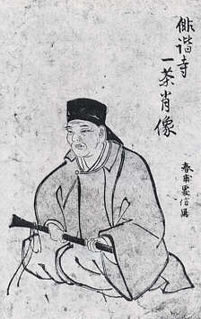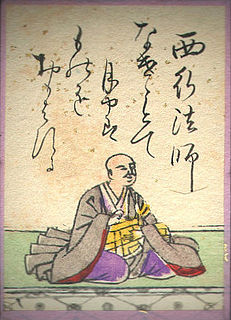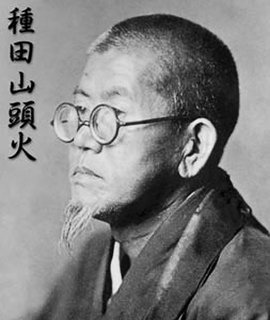 W
WBai Juyi, courtesy name Letian, was a renowned Chinese poet and Tang dynasty government official. Many of his poems concern his career or observations made about everyday life, including as governor of three different provinces. He achieved fame as a writer of verse in a low-key, near vernacular style that was popular throughout China, in Korea and Japan.
 W
WCho Oh-hyun was a South Korean poet and Zen Buddhist monk.
 W
WDōgen Zenji, also known as Dōgen Kigen (道元希玄), Eihei Dōgen (永平道元), Kōso Jōyō Daishi (高祖承陽大師), or Busshō Dentō Kokushi (仏性伝東国師), was a Japanese Buddhist priest, writer, poet, philosopher, and founder of the Sōtō school of Zen in Japan.
 W
WFujiwara no Shunzei was a noted Japanese poet and nobleman, son of Fujiwara no Toshitada. He was also known as Fujiwara no Toshinari or Shakua (釈阿); in his younger days (1123–67), he gave his name as Akihiro (顕広), but in 1167, changed to Shunzei. He was noted for his innovations in the waka poetic form, and for his achievement in compiling Senzai Wakashū, the seventh Imperial anthology of waka poetry; this work was at the behest in 1183 of the Retired Emperor Go-Shirakawa, who despite Shunzei's low rank, admired him. Go-Shirakawa's trust in Shunzei is significant, as Imperial anthologies were landmarks in the poetic circles of the court, second to no other events in significance; poets were literally willing to risk their lives just for the chance to have a poem included. The Tale of the Heike relates that Shunzei was compiling the Senzai Wakashū during the Genpei War, and that Taira no Tadanori ventured into enemy territory to Shunzei's residence, asking him to include a particular poem of his, and then managed to successfully escape back to his own forces without being apprehended. Shunzei eventually did decide to include Tadanori's poem, but attributed it to "Anonymous." His son, Fujiwara no Teika, is considered one of the four best poets in Japanese history.
 W
WHanshan is a figure associated with a collection of poems from the Chinese Tang Dynasty in the Taoist and Chan tradition. No one knows who he was, when he lived and died, or whether he actually existed. In the Chinese Buddhist tradition, Hanshan and his sidekick Shide are honored as emanations of the bodhisattvas Mañjuśrī and Samantabhadra, respectively. In Japanese and Chinese paintings, Hanshan is often depicted together with Shide or with Fenggan, another monk with legendary attributes.
 W
WJakuren (寂蓮) (1139–1202) was a Japanese Buddhist priest and poet. He was adopted by the noted poet Fujiwara no Shunzei upon the death of Shunzei's younger brother. Shunzei originally intended for Sadanaga to be his heir; however, he subsequently had two male offspring of his own, and Sadanaga was forced to step aside in favor of Fujiwara no Sadaie. As was common practice at the time, he became a monk, and acquired the religious name of Jakuren. Taking Saigyo as his model, he traveled around the country, composing poems of his travels. He was well regarded in his time and frequently associated with Fujiwara no Teika. He was one of the six compilers of the eighth imperial waka anthology, the famous Shin Kokin Wakashū, and thirty-five of his poems were selected for the work. Before he died, he adopted Fujiwara no Ietaka, pupil to Shunzei. One of his poems was included in the famous poetry anthology Hyakunin Isshu.
 W
WJien was a Japanese poet, historian, and Buddhist monk.
 W
WKamo no Chōmei was a Japanese author, poet, and essayist. He witnessed a series of natural and social disasters, and, having lost his political backing, was passed over for promotion within the Shinto shrine associated with his family. He decided to turn his back on society, took Buddhist vows, and became a hermit, living outside the capital. This was somewhat unusual for the time, when those who turned their backs on the world usually joined monasteries. Along with the poet-priest Saigyō he is representative of the literary recluses of his time, and his celebrated essay Hōjōki is representative of the genre known as "recluse literature".
 W
WKobayashi Issa was a Japanese poet and lay Buddhist priest of the Jōdo Shinshū sect known for his haiku poems and journals. He is better known as simply Issa (一茶), a pen name meaning Cup-of-tea. He is regarded as one of the four haiku masters in Japan, along with Bashō, Buson and Shiki — "the Great Four."
 W
WKūkai, also known posthumously as Kōbō Daishi , was a Japanese Buddhist monk, civil servant, engineer, scholar, poet, artist and calligrapher who founded the esoteric Shingon school of Buddhism. He travelled to China, where he studied Tangmi under the monk Huiguo. Upon returning to Japan, he founded Shingon—the Japanese branch of Vajrayana Buddhism. With the blessing of several Emperors, Kūkai was able to preach Shingon teachings and found Shingon temples. Like other influential monks, Kūkai oversaw public works and constructions. Mount Kōya was chosen by him as a holy site, and he spent his later years there until his death in 835 AD.
 W
WMatsuo Bashō , born Matsuo Kinsaku , then Matsuo Chūemon Munefusa , was the most famous poet of the Edo period in Japan. During his lifetime, Bashō was recognized for his works in the collaborative haikai no renga form; today, after centuries of commentary, he is recognized as the greatest master of haiku. He is also well known for his travel essays beginning with “Records of a Weather-Exposed Skeleton” (1684), written after his journey west to Kyoto and Nara. Matsuo Bashō's poetry is internationally renowned, and, in Japan, many of his poems are reproduced on monuments and traditional sites. Although Bashō is justifiably famous in the West for his hokku, he himself believed his best work lay in leading and participating in renku. He is quoted as saying, "Many of my followers can write hokku as well as I can. Where I show who I really am is in linking haikai verses."
 W
WKenji Miyazawa was a Japanese novelist and poet of children's literature from Hanamaki, Iwate, in the late Taishō and early Shōwa periods. He was also known as an agricultural science teacher, a vegetarian, cellist, devout Buddhist, and utopian social activist.
 W
WMurasaki Shikibu was a Japanese novelist, poet and lady-in-waiting at the Imperial court during the Heian period. She is best known as the author of The Tale of Genji, widely considered to be the world's first novel, written in Japanese between about 1000 and 1012. Murasaki Shikibu is a descriptive name; her personal name is unknown, but she may have been Fujiwara no Takako , who was mentioned in a 1007 court diary as an imperial lady-in-waiting.
 W
WTachibana no Nagayasu , also known was Nōin (能因), was a Japanese poet and monk of the late Heian period.
 W
WSaigyō Hōshi was a famous Japanese poet of the late Heian and early Kamakura period.
 W
WSakugen Shūryō was a Japanese Zen Buddhist monk, a poet and diplomat in the Muromachi period. He was the chief envoy of a 1547 mission sent by the Ashikaga shogunate to the court of the Jiajing Emperor in Beijing.
 W
WIio Sōgi, generally known as Sōgi , was a Japanese poet. He came from a humble family from the province of Kii or Ōmi, and died in Hakone on September 1, 1502. Sōgi was a Zen monk from the Shokokuji temple in Kyoto and he studied poetry, both waka and renga. In his 30s he became a professional renga poet.
 W
WTaneda Santōka was the pen-name of a Japanese author and haiku poet. He is known for his free verse haiku — a style which does not conform to the formal rules of traditional haiku.
 W
WTon'a , also read as Tonna; lay name – Nikaidō Sadamune 二階堂貞宗. A Japanese Buddhist poet, student of Nijō Tameyo. Ton'a took a tonsure at Enryaku-ji Temple, but was later associated with the Ji sect 時宗. He looked up to Saigyō's poetic genius. Here are two of his most well-known poems: